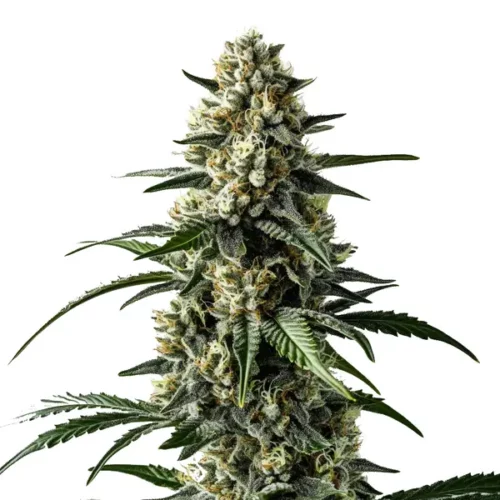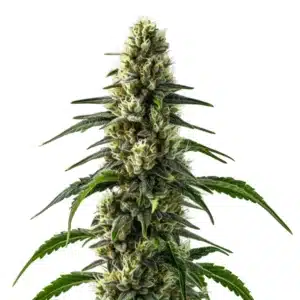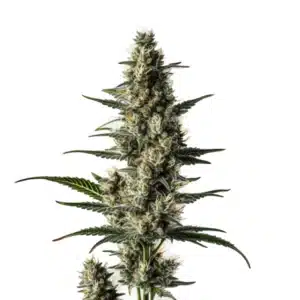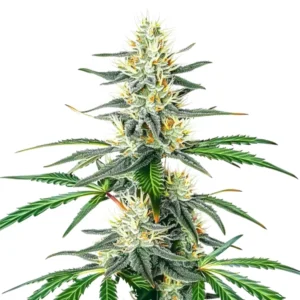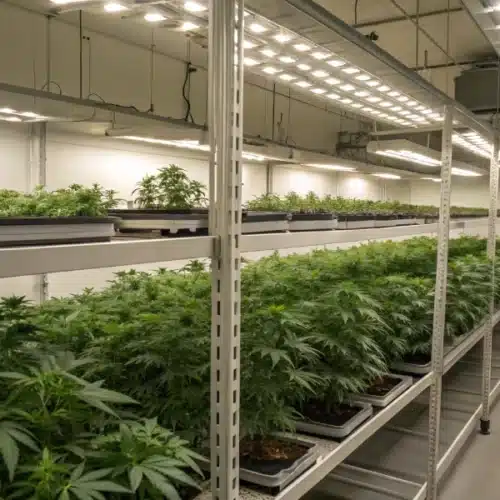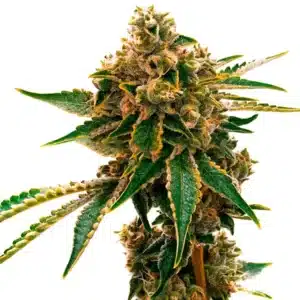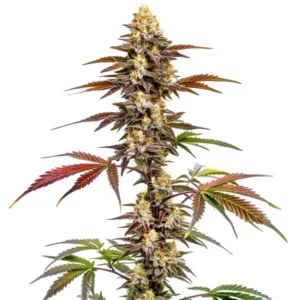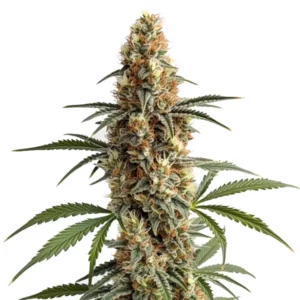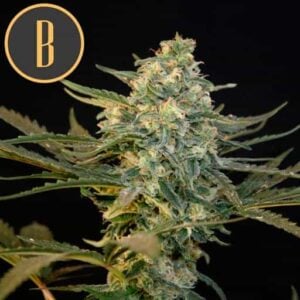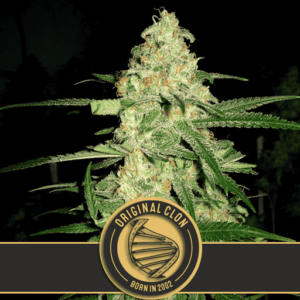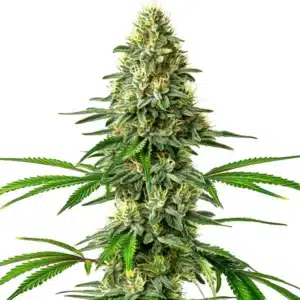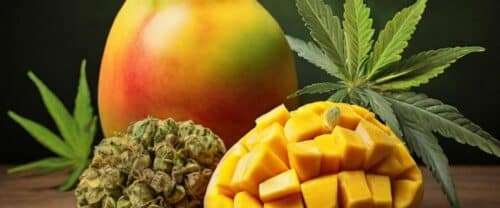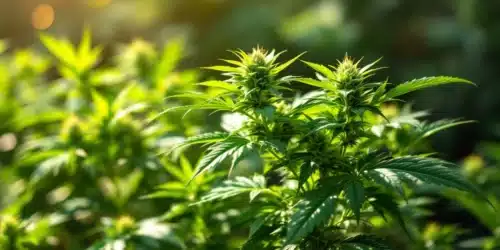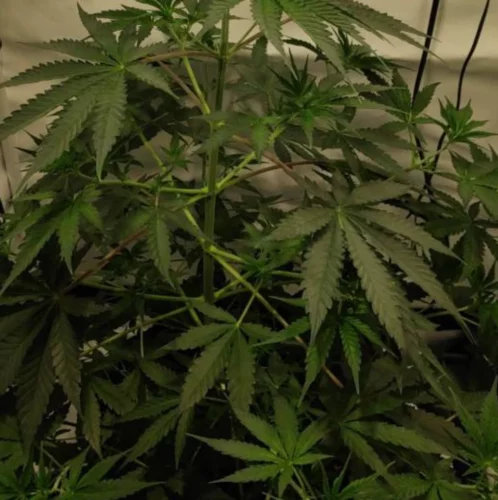When you decide to grow Mango cannabis seeds indoors, you embark on a journey to cultivate a potent, aromatic strain within a controlled environment. Mango cannabis is known for its delightful tropical flavors and a smooth high that captivates many cannabis enthusiasts. Whether you’re new to growing or experienced, learning how to grow Mango cannabis seeds indoors offers the perfect way to maximize yield and potency while enjoying its unique qualities.
Recommended Strains
Mango
 THC: 20% - 22%
THC: 20% - 22% Type of seed: Feminized
Type of seed: Feminized Phenotype: Mostly Indica
Phenotype: Mostly Indica Day to flower: 8 - 10 weeks
Day to flower: 8 - 10 weeks
CBD Mango (1:1)
 THC: 6% - 8%
THC: 6% - 8% Type of seed: CBD
Type of seed: CBD Phenotype: Mostly Sativa
Phenotype: Mostly Sativa Day to flower: 10 - 12 weeks
Day to flower: 10 - 12 weeks
Getting Started with Growing Mango Cannabis Seeds Indoors
Mango Cannabis Strain Characteristics
Mango cannabis stands out due to its sweet tropical flavors reminiscent of ripe mangoes, delivering a smooth and balanced high that blends physical relaxation with mental euphoria. The strain is indica-dominant, which means it tends to grow shorter and bushier, perfect for indoor cultivation. One of the key traits of Mango cannabis is its thick, resinous buds that pack potency, making it a favorite for both recreational and medicinal users.
Indoors, Mango cannabis plants can yield around 400 to 500 grams per square meter under optimal conditions. They typically flower in about 9 to 11 weeks, providing a reasonable timeline for growers who want high-quality results. Understanding these traits helps set you up for success, allowing you to plan for the plant’s needs as it grows.
Why Choose Indoor Growing for Mango Cannabis Seeds?
Growing Mango cannabis seeds indoors offers several advantages, especially for those looking to control every aspect of the environment. Indoor cultivation allows you to regulate lighting, temperature, and humidity, creating ideal conditions for maximizing your yield. Plus, by growing indoors, you protect your plants from pests, weather fluctuations, and other outdoor variables.
Additionally, Mango cannabis is particularly sensitive to its environment, making indoor growing perfect for those aiming to achieve consistent potency and flavor. With the right setup, you can enjoy a higher yield and better control over the plant’s overall health.
Promos & Deals
Preparing Your Indoor Growing Space for Mango Cannabis
Choosing the Best Grow Lights for Mango Cannabis
Lighting is one of the most critical factors in growing Mango cannabis seeds indoors. The strain thrives under intense light, so choosing the right grow lights can make all the difference. LED lights are a popular option because they provide the full spectrum of light without overheating your grow space. They are energy-efficient and offer adjustable settings, making them ideal for both the vegetative and flowering stages.
HPS (High-Pressure Sodium) lights are another option for more experienced growers, offering high-intensity light that encourages faster growth and bigger buds. Regardless of the type you choose, aim to provide at least 18 hours of light per day during the vegetative stage, switching to 12 hours of light during the flowering phase.
Optimal Temperature and Humidity Levels
Temperature and humidity levels are key factors in how well your Mango cannabis plants thrive. The ideal temperature for Mango cannabis indoors is between 70 and 80°F (21-27°C) during the day, with slightly cooler nights. Maintaining consistent temperatures ensures healthy growth and prevents environmental stress.
For humidity, Mango cannabis prefers a range of 40-60% during the vegetative stage, dropping to around 40% or lower during flowering to prevent mold and mildew. Using a dehumidifier and proper ventilation will help you manage these levels effectively.
Selecting the Right Soil and Nutrients for Mango Seeds
Organic vs. Synthetic Nutrients for Mango Cannabis
Choosing the right nutrients is key to achieving optimal growth with Mango cannabis. During the vegetative stage, focus on nitrogen-rich fertilizers to promote leafy green growth. As the plant moves into the flowering stage, switch to a phosphorus-heavy nutrient mix to encourage robust bud development.
Organic nutrients, such as compost or worm castings, can help improve the flavor profile and create a more natural growing environment. However, synthetic nutrients may provide faster results if you’re aiming for maximum yield. Whatever you choose, balance is essential, too many nutrients can lead to nutrient burn, while too few will stunt growth.
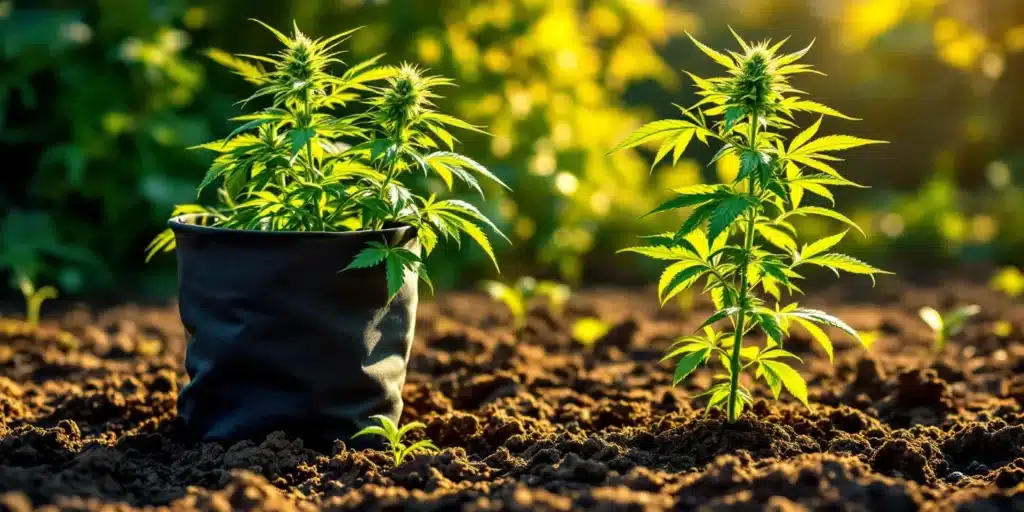
Soil or Hydroponics: Which is Better for Mango Indoors?
When growing Mango cannabis seeds indoors, you have the option to plant in soil or use a hydroponic system. Soil is a great choice for beginners, offering a forgiving medium that helps develop rich flavors. Look for well-draining soil mixed with perlite or coco coir for improved aeration.
For growers who want faster results and bigger yields, hydroponics may be the better option. Hydroponic systems allow the plants to absorb nutrients more efficiently, accelerating growth and maximizing bud production. However, hydro setups require more attention to detail and higher upfront costs.
Growing Techniques to Maximize Mango Cannabis Yield Indoors
Low-Stress Training (LST) for Better Light Distribution
One of the most effective ways to maximize yield with Mango cannabis indoors is through low-stress training (LST). By gently bending and tying down the branches, you expose more bud sites to light, encouraging even growth throughout the plant. LST is especially useful for Mango’s bushy structure, as it helps create a more open canopy.
By using LST, you’ll not only increase the light exposure to the lower branches, but also improve airflow, reducing the risk of mold or pests. Start training your plants early in the vegetative stage for the best results.
Topping and Pruning for Optimal Indoor Growth
Topping is another valuable technique for indoor growers looking to boost yields. By cutting the main stem early in the vegetative stage, you encourage the plant to develop multiple colas, leading to more bud production. Mango cannabis responds well to this method, producing a fuller, more even canopy.
Pruning is also important to keep your plants healthy. Removing lower leaves and small branches that don’t receive much light helps improve airflow and directs more energy toward the main bud sites. Regular pruning reduces the chance of pest infestations and allows your Mango cannabis plants to focus on producing high-quality buds.
Watering and Feeding Mango Cannabis Indoors
How to Water Mango Cannabis Indoors
Watering Mango cannabis indoors requires a careful balance. Overwatering is one of the most common mistakes, so make sure the soil has time to dry out between watering sessions. Use pots with drainage holes to prevent waterlogging, and consider using a moisture meter to determine when it’s time to water.
In hydroponic systems, monitor the water’s pH and nutrient levels closely. Mango cannabis prefers slightly acidic water with a pH level between 6.0 and 6.5. Keeping the water in this range helps prevent nutrient lockout and promotes healthy growth.
Feeding Schedules for Optimal Growth
Establishing a feeding schedule for Mango cannabis is essential for consistent growth. During the vegetative stage, provide a nutrient solution high in nitrogen to encourage strong foliage. As the plant transitions into flowering, increase the phosphorus and potassium levels to promote bigger, denser buds.
Watch for signs of nutrient deficiencies, such as yellowing leaves or stunted growth. These can indicate a lack of certain nutrients, which can be corrected with a balanced feeding schedule.
Enhancing Mango Cannabis Flavor and Potency Indoors
Boosting Terpene Production for Richer Flavor
One of the standout features of Mango cannabis is its unique flavor profile, which can be enhanced by focusing on terpene production. spray Terpenes are the aromatic compounds in cannabis that contribute to the flavor and scent of the buds. To maximize terpene production indoors, you need to create an optimal environment. Using organic nutrients can help preserve and boost terpene development, as these natural compounds allow the plant to express its full flavor potential without chemical interference.
Lighting also plays a role in terpene production. Full-spectrum LED lights that closely mimic sunlight are ideal, as they support healthy terpene development. Additionally, lowering the temperature slightly during the final weeks of flowering (to around 65-70°F) can encourage the plant to produce more terpenes, resulting in stronger aromas and flavors. This technique is known as “cold shock,” and many growers use it to enhance the overall sensory experience of their harvest.
Increasing Potency Through Advanced Growing Techniques
If you’re looking to increase the potency of your Mango cannabis, there are several techniques you can implement during the growing process. Stress techniques such as super cropping can help stimulate the plant to produce more resin, which in turn increases THC levels. Super cropping involves gently pinching and bending the plant’s stems to create micro-injuries, prompting the plant to strengthen and increase resin production as a defense mechanism.
Another method for enhancing potency is controlling CO2 levels in your grow space. Higher CO2 concentrations (around 1200-1500 ppm) during the vegetative and early flowering stages can accelerate growth and contribute to more robust buds. By optimizing both your growing techniques and environmental controls, you can cultivate Mango cannabis with higher THC levels and a richer terpene profile.
Flowering and Harvesting Mango Cannabis Indoors
Signs That Mango Cannabis Is Ready for Harvest
The flowering stage is an exciting time for growers, as Mango cannabis plants begin to produce sticky, resinous buds. Typically, Mango plants take around 9 to 11 weeks to flower, but the exact timing can vary depending on growing conditions. Keep a close eye on the trichomes (the tiny crystals on the buds) as they change from clear to cloudy, signaling that it’s time to harvest.
Harvesting too early can reduce potency, while waiting too long can lead to a loss of flavor. Aim to harvest when most trichomes are cloudy with a few turning amber for the best results.
Techniques for Curing Mango Buds for Best Flavor
Proper curing is key to enhancing the flavor and potency of your Mango cannabis buds. After harvesting, hang the buds in a dark, well-ventilated room with temperatures around 60-70°F and humidity between 45-55%. After 7-10 days of drying, transfer the buds to airtight glass jars for curing.
Open the jars daily for the first few weeks to allow fresh air in, then store them in a cool, dark place. Curing for 2-4 weeks will improve the flavor, making your Mango buds smoother and more aromatic.
Troubleshooting Indoor Mango Cannabis Grows
Issues with Indoor Mango Plants
Even experienced growers can run into problems when growing Mango cannabis seeds indoors. issues include nutrient deficiencies, which can manifest as yellow or browning leaves, and environmental stress due to improper temperature or humidity levels. Monitor your plants closely and make adjustments as needed to avoid these problems.
Optimizing Indoor Conditions for Best Yield
If your Mango cannabis plants are not reaching their full potential, consider optimizing your indoor conditions. Ensure your lighting is strong enough, adjust temperature and humidity levels, and review your nutrient feeding schedule. By fine-tuning these elements, you can boost your yields and achieve healthier, more potent plants.

Week-by-Week Guide for Growing Mango Cannabis Seeds Indoors
Week 1: Germination and Early Growth
During the first week, focus on properly germinating your Mango cannabis seeds. Start by soaking the seeds in water for 12-24 hours to soften the shell, then transfer them to a moist paper towel or a growing medium like rockwool cubes. Keep them in a warm, dark place to promote sprouting. Once the seeds sprout, carefully plant them in your chosen growing medium, about ½ inch deep. At this stage, use gentle lighting and ensure that the growing environment remains warm, between 70-75°F.
Week 2-3: Seedling Stage
As the Mango seedlings emerge, they will start developing their first sets of leaves. During weeks two and three, focus on providing a stable environment with gentle lighting (around 18-20 hours per day). Keep the humidity levels between 60-70% to ensure proper hydration without overwatering. During this stage, avoid using heavy nutrients, and stick to a light, balanced nutrient solution to prevent burning the young seedlings.
Week 4-5: Vegetative Growth
Once your Mango cannabis plants enter the vegetative stage, their growth will accelerate. During weeks four and five, switch to stronger lighting (400-600W LEDs or HPS lights) and ensure your plants receive 18-24 hours of light daily. This is when you should begin training techniques like low-stress training (LST) or topping to encourage lateral growth and increase bud sites. Increase the nitrogen in your nutrient mix to support healthy leaf development, and keep the temperature between 70-80°F with humidity levels around 50%.
Week 6-8: Vegetative Stage Continued
As your Mango cannabis plants continue to thrive, focus on monitoring their nutrient intake and environmental conditions. You can add a bit more potassium and phosphorus to the nutrient mix to promote root and stem growth. Keep up with any training techniques and ensure the plants have plenty of space to grow. This stage is important for developing a strong foundation for flowering, so give your plants time to reach their full potential before flipping to the flowering stage.
Week 9-11: Flowering Stage Begins
When your Mango cannabis plants begin to flower, change the light cycle to 12 hours on, 12 hours off. This triggers the plant to start producing buds. Start feeding your plants with a bloom-specific nutrient solution that’s higher in phosphorus and potassium to support bud development. Maintain a lower humidity level, around 40%, to prevent mold, and keep the temperature between 65-75°F.
Week 12-14: Flowering and Bud Development
As the flowering stage progresses, you’ll start to notice trichome production and the development of dense buds. Continue to monitor light exposure and make sure your Mango cannabis plants have access to ample airflow to prevent moisture buildup. Stick to your bloom nutrient schedule and avoid overfeeding. Trichomes will begin to change color from clear to cloudy, signaling that the buds are reaching maturity.
Week 15-16: Final Weeks of Flowering and Harvest
In the final two weeks, stop feeding your Mango cannabis plants any nutrients and switch to plain water to flush out any remaining salts and chemicals. This will ensure a smoother smoke and better-tasting buds. Keep a close eye on the trichomes and pistils, when most of the trichomes are cloudy with some amber, your Mango cannabis plants are ready to harvest. Carefully trim the buds and hang them to dry before moving on to the curing process.
This week-by-week guide will help you navigate the entire growing cycle, ensuring your Mango cannabis seeds produce high-quality, potent buds.
FAQs for Growing Mango Cannabis Seeds Indoors
How long does it take to grow Mango cannabis seeds indoors?
Growing Mango cannabis seeds indoors typically takes around 12 to 16 weeks from seed to harvest, depending on your growing conditions and techniques. This includes a vegetative stage of 4 to 6 weeks and a flowering stage that lasts around 8 to 10 weeks.
What type of lighting is best for growing Mango cannabis indoors?
Full-spectrum LED lights are ideal for growing Mango cannabis seeds indoors. These lights mimic natural sunlight, promoting strong growth during the vegetative stage and maximizing bud development during flowering. High-pressure sodium (HPS) lights can also be effective, especially during the flowering stage.
How much water does Mango cannabis need when grown indoors?
Mango cannabis plants should be watered thoroughly but not too frequently. Watering once every 2-3 days is typical, depending on your soil and container size. Ensure the growing medium dries out between watering sessions to avoid overwatering and root rot.
What is the optimal temperature for growing Mango cannabis seeds indoors?
The optimal temperature for growing Mango cannabis indoors is between 70-80°F during the vegetative stage and 65-75°F during the flowering stage. Maintaining stable temperatures helps prevent plant stress and promotes healthy growth.
Can I grow Mango cannabis seeds in a small indoor space?
Yes, Mango cannabis seeds can be grown in small indoor spaces. Using training techniques like low-stress training (LST) and topping can help control the plant’s height and shape, making it suitable for compact growing environments like grow tents or small rooms.

